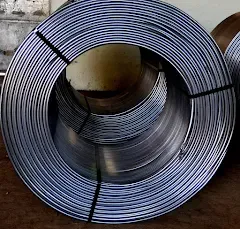Magnesium Cored Wire Feeder for High-Quality Ferro Silicon Magnesium Output
The production of high-quality ferro silicon magnesium (FeSiMg) is critical for industries like steelmaking and foundries, where it plays a vital role in improving the mechanical properties of metals. One of the most efficient technologies aiding this process is the magnesium cored wire feeder system. This innovative approach not only optimizes the alloying process but also ensures consistency, precision, and cost-efficiency in production.
What is a Magnesium Cored Wire Feeder?
A magnesium cored wire feeder is a specialized system designed to inject magnesium cored wire into molten metal. The cored wire consists of magnesium alloy, enclosed in a thin steel sheath, which is fed into the molten metal bath at a controlled rate. The magnesium reacts with the molten metal to create a uniform and high-quality ferro silicon magnesium alloy.
This system is particularly useful in desulfurization and nodularization processes, which are essential for producing ductile iron and other high-performance materials.
Key Features:
Precision Injection: The system delivers the magnesium cored wire at an exact depth and speed, ensuring consistent reactions in the molten bath.
Automated Control: Modern feeders come equipped with programmable systems, allowing operators to adjust parameters based on the specific requirements of the alloy.
Durable Build: These feeders are constructed with high-grade materials to withstand the harsh conditions of foundries and steel plants.
Compatibility: They can handle different wire diameters and compositions, making them versatile for a range of applications.
Advantages of Using a Magnesium Cored Wire Feeder
Enhanced Alloy Quality: The precise and controlled injection of magnesium ensures a uniform distribution of the alloying element. This eliminates inconsistencies and enhances the mechanical properties of the final product, such as strength, ductility, and toughness.
Reduction in Alloying Costs: The efficient use of magnesium through controlled feeding minimizes wastage, leading to significant cost savings. Additionally, the improved quality reduces the need for rework and rejects.
Improved Safety: Direct injection of cored wire into the molten bath reduces the risks associated with handling loose magnesium or other reactive elements.
Minimized Environmental Impact: The closed feeding system reduces emissions and spillage, contributing to a cleaner and safer working environment.
Higher Productivity: The automated process ensures faster and more consistent production, reducing downtime and increasing output.
Applications in Ferro Silicon Magnesium Production
Magnesium cored wire feeders are widely used in:
Ductile Iron Production: Ensuring proper nodularization of iron to achieve superior mechanical properties.
Steelmaking: Enhancing desulfurization processes, which is crucial for producing high-grade steel.
Foundries: Achieving precise alloy compositions for custom casting requirements.
Steps in the Cored Wire Injection Process
Preparation: The molten metal bath is prepared at the required temperature.
Wire Feeding: The magnesium cored wire is fed into the molten metal using the feeder system at a controlled speed and depth.
Reaction: Magnesium reacts with the sulfur and oxygen in the molten metal, forming non-metallic inclusions that float to the surface and are removed.
Final Alloy Formation: The result is a uniform and high-quality ferro silicon magnesium alloy ready for further processing or casting.
Innovations in Feeder System Technology
Recent advancements in feeder technology have introduced features such as:
Smart Sensors: For real-time monitoring of feeding speed and temperature.
Data Analytics: To analyze production efficiency and optimize feeding parameters.
Energy Efficiency: Systems designed to reduce energy consumption while maintaining performance.
Choosing the Right Feeder System
When selecting a feeder system, consider:
Capacity: Ensure the system can handle the required production volume.
Compatibility: Check if it supports the wire diameter and composition needed for your application.
Automation: Look for systems with programmable features for ease of operation.
Durability: Opt for feeders made of high-quality materials that can withstand extreme conditions.
Conclusion
A magnesium cored wire feeder is a game-changing tool for producing high-quality ferro silicon magnesium alloys. By ensuring precision, reducing costs, and improving safety, these systems have become indispensable in industries like steelmaking and foundries. As technology continues to advance, these feeders are set to play an even more significant role in optimizing metallurgical processes and meeting the demands of modern manufacturing.
#Magnesiumcoredwirefeeder #Coredwireinjection #Magnesiumcoredwireinjectionsystem #Ferrosiliconmagnesium




Comments
Post a Comment